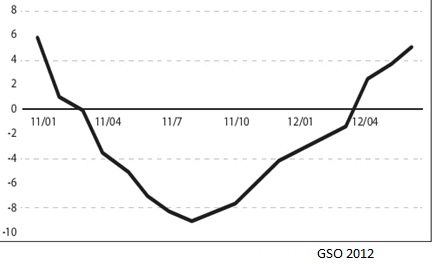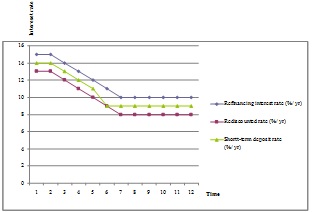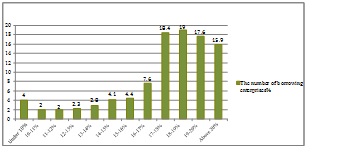The impact of the coordination of monetary policy and fiscal policy to Vietnamese businesses in the period 2011-2014
Lessons from the past
Since 2007, as the economy has been deeply integrated into the global economy, Vietnam also has been affected by the world economic-financial crisis in 2008, 2009. The complex evolution of the domestic economy and the world economy made Vietnam face with many uncertainties in the macro economy. To deal with this reality, the macroeconomic policy, especially fiscal policy and monetary policy are required adjustments and tighter coordination to stabilize the economy and maintain growth.
To prevent economic recession, monetary policy has been loosened with tightened fiscal policy in 2009, 2010. The loosening and expansion of these two policies helped to maintain 5.3% growth in 2009 and inflation at 6.8%, lower than two years previous1. Entering 2010, while monetary policy was tightened gradually, fiscal policy was overextended, especially in public investment to achieve higher growth in 2009. As a result, although the economic growth in 2010 reached 6.78% in 2010, the inflation rose to 11.75%1, almost 2 times higher than that of 2009 and is one of the few countries worldwide have inflation rate with 2 digits. The same thing occurred in 2010, affecting to inflation in 2011.
In 2009 – 2010, the loosening of fiscal and monetary policies had been proved to maintain growth rate efficiently but it also cause inflationary pressures on the economy. The manufacturing input price was increased, the ability to access to capital was not improved and the implementation of reducing tax in 2009 was not really effective. All these factors made many businesses got difficulties and had no income subsequently they couldn’t enjoy preferential policies of tax on enterprise income. The policy of rate in 2009 in fact had lent all business with excess capital, using capital for wrong purposes, overlapping objects and who loan supporting interest capital and then transferred to the deposit. This situation limited the small and medium-sized businesses ‘ability to access to capital, while enabled ineffective enterprises continue functioning and caused further reduce the competitiveness of domestic enterprises in general.
The coordination of fiscal policy and monetary policy in order to make the economy operating under law properly, exploit the tremendous momentum of the market economy for development are Vietnam’s objectives in the current period. However, in reality, this combination has always got more complex issues of the level, timing, manner and mechanism of operation. How to coordinate the two policies rationally and optimally to serve two goals: stability and development is posing problem to be solved, especially in the context of economic difficulties as the period 2011-2014
I. Practices coordination of monetary policy and fiscal policy.
1. Impacts of practice coordination of monetary policy and fiscal policy on businesses early 2011 to early 2012.
From late 2010 and early 2011, the global economy began to recover, but still had some difficulties. It had negative impact on domestic economic situation, as a result, economic growth slowed, inflation was high, and stock market and real estate slump, threatening to macroeconomic stability. In the first 6 months of the year, inflation rose 13.29% compared with the begin of this year and up to 20% compared to the same period of last year, causing difficulties for efforts to curb inflation below 7%/year as set target, lower more than the actual average inflation rate of the previous three years 2008-2010 (12.73%). Therefore, the State Bank of Vietnam (SBV) is required to reduce the money supply and the credit growth abruptly, causing the unwanted consequences: rising interest rates and bad debts, tension on the liquidity of banking system, depleted stock market, frozen real estate market, but actual inflation is still too high at 18,13%. Cause of too high inflation compared to target (<7%) was due to the inevitable consequence of overextension of the money supply and credit growth in the previous stage and partly from the lack of proactive in operating monetary policy.
According to businesses ’opinions, 2011 was the most difficult year in the last 10 years, contrary to expectation that it will be a year of reaping success for businesses and investors. After booting the first quarter, the CPI smoothly jumped too strong, and this time the Government had assessed it seriously – from the accumulation of instability in the economic structure and investment for years. There were two main reasons: one is abundance and inefficiency in public investment, including investment on infrastructure and state enterprises; two is excessiveness of edit growth, primarily serving financial speculation. Therefore, the Government had released the Resolution 11 to tighten the money supply and credit, significantly reduced real estate lending to curb inflation and stabilize the economy.
Resolution 11/NQ-CP dated 24/02/2011 of the Government on the measures mainly to curb inflation, stabilize the macro economy and ensure social security has given policy to implement tightening the monetary policy. In the process of implementing this policy, besides the positive sides, the negative side of this policy is a condition of lack of capital for the economy that has pushed many businesses into difficult situations. From 3/2011, with the aim of limiting credit growth, processing the situation that rival banks increase deposit rates to attract deposits from residential sources, the state bank has taken a series of measures to set the deposit rate cap for deposits in Vietnam dong. When inflation is not controlled and remained at a high level, the setting of the maximum interest rate has led to the implementation of policy negative “percentage yield” throughout 2011. It was not until May 4/2012, inflation was reduced and deposit rate became positive (Figure 1).
Figure 1: annual percentage yield (applied to deposit 1 month) in 2011-2012
Along with setting the deposit rate cap, the state bank has taken measures to control the speed of credit growth below 20% and the total payment about 15-16%3, adjust the structure of credit towards concentration of capital for agricultural production and rural development, export, supporting industries, small and medium-sized enterprises; limit lending to non-production sectors to ensure the proportion of lending to non-production sectors down to 22% until 30/06/2011 and down to 16% to 31/12/20113.
Inflation has been curbed and tends to decrease, but the side effect of the policy begins to reveal, the intrinsic difficulties of the economy is still not resolved while the world economy is still not out of recession, as a result, Vietnam’s economy in general, and businesses in particular now are entering a difficult period. The intervention of government in this context is essential. Consequently, the government has launched several solution packages to remove constraints, support market, especially tax policies have directly helped many businesses get out of the crisis and continue to grow. Specifically:
– Decision No. 21/2011/QD-TTg dated April 6, 2011 by the Prime Minister on the extension for income tax of small and medium enterprises to overcome difficulties, contributing to promote economic development in 2011. The main content is the extension on paying tax during 1 year from the deadline for tax payment under the law of Tax Administration for payable enterprise income tax by small and medium-sized enterprises.
– Resolution No. 08/2011/QH13 dated August 6, 2011 of the National Assembly of the Socialist Republic of Vietnam period XIII, the first session ratified the additional promulgation of some tax solutions to remove difficulties for businesses and individuals. There are several guiding documents for the implementation of Decree 101/2011/ND-CP, Circular No. 154/2011/TT-BTC. The main content is reducing 30% of payable corporate income taxes in 2011 for small and medium businesses and enterprises using many labor in production, processing, processing of agricultural, forestry and aquatic products, textiles, footwear, electronic components, construction of socioeconomic infrastructure.
Although the Government wants to implement fiscal policies through tax breaks in order to support the enterprises, particularly small and medium enterprises; it hasn’t worked effectively yet at that time. Because many companies were loss-making; therefore; tax breaks would not have much impacts on these companies. What these enterprises really need at that time was the money to expand their business. However, the lending rates remained high as well as the lending requirement were quite strict because of bad debt worries; therefore; the enterprises have found difficult to access the capital.
According to the data of The General Statistics Office, in 2011, the total number of newly established enterprises in Viet Nam were 77.458, which decreased 7,2% compared with the same period in 2010. The total registered capital of these enterprises was 513.000 billion dong, which rose up 4,9% compared to 2010. Thus, 2011 has been the first time since the Business Law 1999 came into forces that the number of newly established enterprises has decreased significantly over the same period of last year. Together, the dissolution or discontinuance of some companies have rapidly increased compared to the previous year. According to the data of The Chamber of Commerce and Industry of Viet Nam and The World Bank, by the end of 2011, there were 79014 companies which have been dissolved or bankrupted; of which, according to The General Department of Taxation, the number of enterprises which has paid taxes in 2011 were just 400.000 of 600.000 enterprises had tax code. That means there were a very large number of dissolved or bankrupted businesses did not have business registration or already have it but did not work officially. In the first quarter of 2012 alone, this number was about 12.000, while the number of newly established enterprises at that time was only 17.8006. The dissolution or discontinuance of enterprises are common for some developing economies like Viet Nam; however; the highly increase of this figure currently as well as the impacts as mentioned above shows that the domestic production has been in trouble. The predicament of enterprises have affected the national economic growth.
Generally, we have achieved some targets in the 2011 Resolution No.11/NQ-CP, including controlling inflation, reducing trade deficit, stabilizing the exchange rates and decreasing the budget deficit. Therefore, the economic decline could be seen as the side effect and this situation remained under control. The difficulty of companies occurred partly because of unstable and unpredictable macroeconomic policies, partly because of the growth pattern which did not focus on improving productivity, the efficiency of both the economy and businesses itself. The business support launched by the Government was essential for enterprises. Nevertheless, the business themselves also needed to adjust their business operations to adapt with new environment. Besides, The authority was required to maintain the stable macroeconomic policies in order to succeed in economic reconstruction.
1. Experiences of the coordination between fiscal policy and monetary policy that have had impacts on enterprises from early 2012 to middle 2014.
The economic situation in the early 2012 has put the policy makers, especially The State Bank of Viet Nam and the Finance Ministry on the dilemma situation. If they had implemented the policy easing, it would have led to the economic recession. On the other hand, if they had maintained the strict policies, many companies would have been bankrupted and the unemployment rates would have been risen up. Under the Guidance of The Government stated in the Resolution No.01/NQ-CP issued on 03/01/2012, The Governor of State Bank has issued the Directive No.01/CT-NHNN on 13/02/2012. Accordingly, the targets for 2012 were defined as ” operating the monetary policy tightly and flexibility; harmoniously coordinating with fiscal policy management in order to stabilize the money market; ensuring the liquidity of the credit institutions; controlling the growth rates of total payment instruments at about 14%-16% and credit at 15%-17% ; reducing the interest rates to consistent with the current economic situation and foreign currency supply and demand; ensuring the operation of the credit institution system; complying with the currency law.
At the beginning of 2012, The Central Bank of Viet Nam has set a target of reducing the capital mobilization interest by 9-10% per year at the end of 2012 and at the same time providing the roadmap of reducing on average 1% per quarter per year. In 2012, The Central Bank has adjusted down the interest rates 4 times, including the refinancing interest rate, the discount rate, the deposit interest rate ceiling so that the enterprises could access to the capital easily.
Graph 2: The fluctuation Interest rates in 2012
Source: The Central Bank of Viet Nam
Tightening the monetary policies has brought about some positive results. The Viet Nam ‘s economy has shown some positive signs such as the CPI was increased only 6.81% compared to December 2011 and 9.21% compare to an average of 2011; high surplus in balance of payment and so on. However, it led to the situation of capital shortage; pushing most enterprises in a difficult situation namely :
– Many enterprises could not access to the capital sources of the Banks. According to the General Statistics Office; at the beginning of May 2012; there were more than 42% of companies did not lend money to do business. In 58% enterprises lending money, there were more than 50% of them borrowed money from State Banks, about 30% enterprises borrowed from commercial banks, others had to borrow friends or relatives,etc..
– The General Statistics Office showed that most of enterprises had to lend money with high interest rates. 78,5% enterprises had to pay interest rates at above 16%; more than half of them had to pay at above 18%. However, according to the report of The Central Bank, the number of enterprises which had to pay the interest rate at above 15% has been gradually increased.
Chart 3: Capital borrowing enterprises (%)
Source : GSO
After the difficult times of Vietnamese economy because of policy easing , the Resolution No 13/NQ-CP issued on 10/05/2012 was a life-saver for the business community in Viet Nam. The Ministry of Finance timely issued the Circular No 83/2012/TT-BTC on 23/05/2012 to guide the Resolution No 13/NQ-CP would be an encouragement for the development of many companies. Basically, the Resolution had met the need of many enterprises and consistent with the world trend which were shifting from “austerity” policies to “growth stimulation” policies, with the notable highlights were as follows :
Reducing the burden of finance and increasing capital for the investment projects: The Government decided to reduce the burden of finance for enterprises through extending the deadline of tax payments by 6 months in the second quarter of 2012 for small and medium enterprises which paid taxes by the deduction method in some areas of productions, processing including agricultural products, forest products, aquatic products, textiles, footwear products, electronic components, infrastructural building for socio-economic purposes.
The government also required to accelerate the implementation and disbursement of projects, investment programs, especially for investment from the State budget, Government bonds and investment from national target program; raising additional VND2,000 billion capital investment loans for solidify canals, developing rural roads, pump stations for agricultural production, infrastructure for aquaculture and agricultural villages; allowed utilization of 2011 funds which have been allocated to 2012.
Reducing the interest burden and debt restructuring: While requires the pro-active uses of flexible tools of monetary policy, ensure credit growth and reasonable total means of payment aiming at controlling inflation targets, the Government stresses the need to continue to lower the lending rate consistently with inflation developments; Priority areas are agriculture and rural development; SME; enterprises producing export goods; industrial enterprise support. At the same time, the implementation to restructure the debt (repayment period, interest rates, new loans to repay the old …) and other necessary measures, in accordance with each type, sector and business to create favorable conditions for enterprises to borrow capital for production and business, especially for companies with growth prospects that the product meets the requirements of the market, but are struggling financially.
Specifically, after 4 months of implementing Resolution 13 / NQ-CP, extended about 11,000 billion VND of value added tax for 190,280 enterprises. Extended 2,868 billion VND of corporate income tax liabilities for 70,300 firms, in which the debt before 2010 contributes nearly 50%. Reducing 50% of land renting rates in 2012 to more than 2,400 businesses with the amount of 250 billion dong10 … In July 2012 – the important month of the declaration of corporate income tax on a quarterly basis and is also the first month of implementation exemption of enterprise income tax for SMEs, enterprises with large use of labor, the Ministry of Finance has taken more than 3,600 billion exemption for SMEs10.
It is realistic to confirm that, these solutions of reducing, extending taxes have helped businesses to increase financial resources, gradually overcome difficulties and restore production, market development. This is reflected in the inventory of enterprises have kept declining in recent months. Through the tax administration, we can see many encouraging signs in production and business. Specifically, of the nearly 25,000 enterprises stopped production and business earlier that year due to difficulties, only in June July, 2012 more than 2,000 businesses re-start their operation again. Number of enterprises with tax declaration reaches 533,000, in which those declared a profit in the first quarter / 2012 rose by 2.4%, quarter II / 2012 increased by 2.8%. Total declaration of VAT increase in July 2012 increased 5.3% compare with the previous month, which is a good sign for the recovery of production and business activities11.
However, the Resolution 13 / NQ-CP, focus mainly on taxes extension, which would force businesses to generate pay for the following year. Not to mention, two strongest solutions are extensions of value added tax and enterprise income tax only helps the firms while they are still selling getting income and profits. While the enterprises who are under big inventory and loss, are not benefited. What they needed most then was the interest rate decreases as quickly as possible, it would save the production, while providing fast turnarounds of money in circulation. According to the General Statistics Office, until end of 31/12/2012, the number of corporate dissolved or suspended operations in the country in 2012 reached 58,000 enterprises11. Meanwhile, the number of newly registered firms in the whole country continue to decline from beginning of the year until December 2012 was 62,794, down 10% in number and 8.4% reduction in registered capital11.
On april,17th,2013, the Prime Minister has officially issued Decision 601 on the establishment of the Development Fund for small and medium- sized enterprises. This is an attempt by the government to help small and medium enterprises to overcome the current difficulties. However, according to the expert’s assessement, since its foundation fund has yet to make an exit of capital for small and medium businesses, because there are not specific institutions. The loans rate accounted for 70% of total working capital of the enterprises. Small and medium enterprises will get more difficulties because they do not have the tools to mortgage for banks. Therefore, the establishment of a separate fund for small and medium-sized enterprises is essential to separate from the long-standing problem which is mainly oriented to large enterprises. The small and medium enterprises have the advantage of a dynamic and flexible. If governments continue to give them funds to invest in creating competitive products and selecting the appropriate delivery method, these enterprises will be found effective in their operations.
In addition, the coordination between fiscal and monetary policy contributed importantly in controlling inflation at 6.04% in 2013 and 6.81% lower than that in 2012. Level of interest rate continued to decline 2-5% / year to facilitate to decrease the borrowing costs of the enterprise, to support enterprises to build up business plans, develop market and calculate the medium and long term goals. Besides, basing on the orientation of the economic restructure of government schemes to 2020, the small and medium enterprises will have better conditions in building long-term business strategy. Until now, it is believed that Vietnam’s economy is showing signs of recovery as indicators of macro-economic growth, inflation, exchange rates, the exports and imports have stable than that of previous year. Specifically, the industrial production index during the first 7 months of 2013 increased by 5.2%, higher than that of the same period in 2012, the inventory plummeted.
In early 2014, basing on the Resolution No. 01 / NQ-CP on January, the 2nd,2014 about plan of socio-economic development in 2014 of the Government, the results achievements and lessons from 2013 as well as evaluation of macro currency, the State bank has issued Directive No. 01 / CT-SB about implementing the monetary policy and ensuring banks operate effectively and safely. According to this direction, the State bank claimed that the central task in 2014 is using monetary policy actively, flexibly, and coordinating closely with fiscal policy to control inflation targets, to stabilize the macroeconomic, to support economic growth at a reasonable level and to ensure the liquidity of the credit institutions and the economy. It is orientated to adjust the appropriate payment facilities increase by about 16-18%, credit increase by about 12-14% and another target will be adjusted in line with the real situation. Moreover, with the corporate income tax rate was reduced by common level from 25% to 22% from january,1st,2014 and following 20% from january,1st,2012, 20% is the tax rate will be applied to small and medium enterprises from july,1st,2013.
The government has tried its best to support enterprises such as reducing and exempting tax, declining the land tax and using land tax, lower the interest rate, the corporate income tax, reforming the administration and so on to encourage the investment and the production. However, in the first 5 months of 2014, there were nearly 27,900 businesses are forced to stop working, or dissolved, up 20.5% compared to the same period in 2013. The number of deactivated and disolved enterprises were less than that of new enterprises (roughly 31.230 enterprises), but the scale of the new enterprises is more and more smaller. On the other hand, accessing the loan of bank still is unsolved problem. According to a survey of business trends of 2014 announced by the General Statistics Office, 23% of enterprises could not get a bank loan , due to complex procedures, time consuming. 4.4% of enterprises did not get a loan due to lack of collateral; 7.8% did not have enough equity capital as required by the bank to get a loan while 6.4% did not want to get the bank loans, because of the additional cost. If these restriction does not soon be overcome, The large amount of capital still lies in bank despite the current interest rate is quite low.
The coordination between monetary policy and the fiscal policy aiming to put the economic in the right operation which is line with the rules and to deploy the giant motivation of the market economic to serve the development is the target of Viet Nam in current period. However, in fact, there is no good coordination between the monetary and fiscal policy in the planning and implementation of policy objects in the short and long term. Monetary policy, on the one hand, aims to curb inflation, but just to maintain the stability of the banking system, sometimes these goals conflict with the requirements of growth or removing difficulties for enterprise systems. The fiscal policy have to control and cut the spending as well as support to enterprises, the State corporation and ensure the social welfare. Thus, it is difficult to make spending cut as well as ensure the distribution of expenditure for the right objects effectively (because of the ineffectiveness in use of the recipients of budget). This lead to the contradictions and difficulties in coordination between the two types of policy in Vietnam.
I. The solution to perfect the coordination of monetary policy and fiscal policy to the enterprise’s activities
1.The solutions from the State and the functional agencies
The State bank need to continue to implement a strict and prudent monetary policy to ensure growth of lending. We not only have to control the inflation but also solve the difficulties about capital for economic. However, instead of controlling interest rates, there should be more tighter measures to control interest rates. Commercial banks should share difficulties with the enterprises by cutting costs, lower profitability indicators and interest rate for enterprises
However, a tightened monetary policy is not an effective solution for the current disease in the economy, since government spending is still a problem. Actually, monetary solutions are drastically exercised and initial effects have emerged in restraining inflation and stabilizing the macro-economy environment. However, budget cut and tight control of public investments are still inefficient.
Therefore, the Government needs to keep increasing the discipline in public investments, specifying criteria for cutting unnecessary projects in the fiscal policy, improving the projects evaluation and decision making processes. If fiscal solutions are well implemented, they will harmonize will monetary policy, which will stabilize the result coming from restraining inflation and improve the business environment for enterprises development.
In addition, we need to accelerate the commercial banking system restructuring process, boost the clearance of information and specify the operation framework and the post-restructuring process.
2. Solutions for attracting firms’ capital:
We need to restructure the business to adapt to current financial situation and current potential of firms. In addition, it is also necessary to carry innovation in the intra-firm management, boost the business evaluation process, plan the strategies… increase financial management activities. Financial data also needs to be publicized to allocate resources more efficiently, reduce cost and risk for both firms and banking system.
Firms need to adjust their business plans considering the tightened supply for loan. With high-cost loans, firms need to ensure their profit maximization by choosing effective investment and business plans, or reduce the capital usage into most basic machinery and avoid wide but inefficient investments.
Firms also should avoid overdependence on bank loans which are very costly, by seeking for alternative capital sources such as employees’ money, strategic partners, customers or capital from merge and acquisitions to be able to overcome hard period time. Moreover, they should use the financial leverage cautiously and flexibly in business practice.
Appendices
SME clarification table (from point 3 in Government decree no. 56/2009/NĐ-CP)
|
Size
Economic field |
Extra-small enterprises |
Small enterprises |
Medium enterprises |
||
|
Numbers of employees |
Total capital |
Numbers of employees |
Total capital |
Numbers of employees |
|
|
I. Agriculture, forestry and fishery |
Less than 10 |
Less than 20 billion VND |
From 10 to 200 |
From 20 to 100 billion VND |
From 200 to 300 |
|
II. Industry and construction |
Less than 10 |
Less than 20 billion VND |
From 10 to 200 |
From 20 to 100 billion VND |
From 200 to 300 |
|
III. Commercial and services |
Less than 10 |
Less than 10 billion VND |
From 10 to 50 |
From 10 to 50 billion VND |
From 50 to 100 |
Lâm Thanh Hà, MA
Diplomatic Academy of Vietnam
References
1. Vietnam Development Conference (03/2012): “Effect of monetary policy and economic recession to Vietnamese firms’ business activities and abilities to access capital.”
2. “Which firms will surpass the recession in 2011”, Au Viet Stock Company (03/2011)
3. “Effect of interest easing policy to firms business”, Research paper no.20, Economy and Policies Research institution, College of Economic, Hanoi National University.
4. Government resolution no. 21/2011/QĐ-TTg, (06/04/2011), published by Prime Minister, about loosening corporate tax collection deadline for small and medium enterprises, to ease economic difficulties, and boost national economy in 2011.
5. Circular no. 52/2011/TT-BTC (22/04/2011), published by Ministry of Finance, for guiding implementation of government resolution no. 21/2011/QĐ-TTg, (06/04/2011), published by Prime Minister.
6. Congress resolution no 08/2011/QH13 (06/08/2011), publish by XIII Congress of Socialist Republic of Vietnam, the first session agreed with the establishment of additional issuance of tax-related solutions to assist firms and individuals.
7. Government resolution no. 101/2011/NĐ-CP (04/01/2011) about detailed guidance for implementing Congress resolution no 08/2011/QH13 (06/08/2011).
8. Resolution no. 54/2011/QĐ-TTg (11/10/2011), published by the Prime Minister about loosening year 2011 – corporate tax collection deadline for firms using many employees in certain economic field, to ease economic difficulties, and boost national economy.
9. Resolution no. 04/2012/QĐ-TTg (19/11/2012), published by the Prime Minister, about loosening corporate tax collection deadline by 3 more months for small, medium and using many employees enterprises’ taxes payable in the first and second quarter of 2011.
10. Government resolution no. 13/2012/NQ-CP (10/05/2012), about solutions to ease difficulty for business and assist the market.
11. Congress resolution no. 29/2012/QH13 (21/06/2012), about issuance of tax-related policies to assist firms and individuals.
12. http://www.sbv.gov.vn/portal/faces/vi/vim/vipages_trangchu/tkttnh/baocaophantich?_adf.ctrl-state=1uygxm355_4&_afrLoop=2164318737874100
13. http://www.gso.gov.vn/default.aspx?tabid=228&ItemID=1915
14. http://www.mof.gov.vn/portal/page/portal/mof_vn





















Il CeSE-M sui social